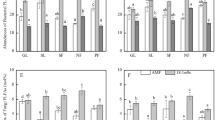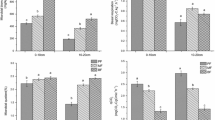Abstract
This study investigates the changes in soil microbial populations as vegetational succession progress from abandoned farmland to climax forest in the Ziwuling Forest, which is located in the northern part of the Loess Plateau, China. Different organic C and total extractable N between the fumigated and non-fumigated soils were assumed to be released from soil microorganisms. Soil microbial C was calculated using Kec = 0.38 and microbial N was calculated using Ken = 0.45. The released P was converted to microbial biomass P using Kep = 0.40. Soil bacteria, fungi, and actinomycetes increased as the vegetational succession progressed. Microbial C was of the highest amount in farmland. Microbial C, N, and P generally increased from abandoned land to climax community. The results indicated significant (P < 0.05) diversities of soil microbial biomass under different vegetation. There was a significant correlation between microbial biomass and soil nutrients. Knowledge about soil microbial populations is important for forecasting vegetational succession and determining the ecological condition of the environment.
Similar content being viewed by others
References
Zhou Y D, Wu J S, Zhao SW, Guo S L, Lu P. Change of soil organic matter and water holding ability during vegetation succession in Ziwuling region. Acta Botanica Boreali-occidentalia Sinica, 2003, 23(6): 895–900 (in Chinese)
Dalal R C, Mayer R J. Long-term trends in fertility of soils under continuous cultivation and cereal cropping in Southern Qeensland, total organic carbon and its rate of loss from the soil profile. Australian Journal of Soil Research, 1986, 24: 281–292
Long J, Li J, Jiang X R, Huang C Y. Soil microbial activities in maolan karst forset, Guizhou Province. Acta Pedologica Sinica, 2004, 41(4): 597–602 (in Chinese)
Zhang P, Guo H J, Dao Z L, Long B Y. Preliminary study on soil biochemical activities in gaoligong mountains. Acta Pedologica Sinica, 2000, 37(2): 275–279 (in Chinese)
Hou Y L, Wang S G, Guo W. Effect of urea application amount on microbes and enzymes in soil. Chinese Journal of Soil Science, 2004, 35(3): 303–306 (in Chinese)
Green J L, Holmen A J, Westoby M, Oliver L, Briscoe D, Dangerfield M, Gillings M, Beattie A J. Spatial scaling of microbial eukaryote diversity. Nature, 2004, 432: 747–750
Rutigliano F A, Ascoli R D, De Santo A V. Soil microbial metabolism and nutrient status in a Mediterranean area as affected by plant cover. Soil Biology & Biochemistry, 2004, 36: 1719–1729
Anderson T H. Microbial eco-physiological indicators to assess soil quality. Agriculture Ecosystems & Environment, 2003, 98: 285–293
Schloter M, Dilly O, Munch, J C. Indicators for evaluating soil quality. Agriculture Ecosystems & Environment, 2003 98: 255–262
Li Y T, Becquer T, Quantin C, Benedetti M, Lavelle P, Dai J. Microbial activity indices: Sensitives soil quality indicators for trace metal stress. Pedosphere, 2005, 15(4): 409–416
Bao S D. Soil and Agricultural Chemistry Analysis. 3rd ed. Beijing: Agricultural Publishing House, 2000, 23–107 (in Chinese)
Cheng L J, Xue Q H. Experimental Technology of Microbiology. Shaanxi: World Publishing Co., Ltd, 2000, 80–83 (in Chinese)
Vance E D, Brookes P C, Jenkinson D S. An extraction method for measuring soil microbial biomass C. Soil Biology and Biochemistry, 1987, 19: 703–707
Cabrera M L, Beare M H. Alkaline persulfate oxidation for determining total nitrogen in microbial biomass extracts. Soil Science Society of America Journal, 1993, 57: 1007–1012
Jenkinson D S. Determination of microbial biomass carbon and nitrogen in soil. In: Wilson J R, ed. Advances in Nitrogen Cycling in Agricultural Ecosystems. Wallingford: Commonwealth Agricultural Bureau International, 1988, 368–386
Brookes P C, Powlson D S, Jenkinson D S. Measurement of microbial biomass phosphorous in soil. Soil Biology and Biochemistry, 1982, 14: 319–329
Yang Y S, He Z M, Yu X T. Changes of soil biological activities after the replacement of broadleaved forest by Chinese fir forest. Chinese Journal of Applied and Environmental Biology, 1997, 3(4): 313–318 (in Chinese)
Zou H Y, Liu G B, Wang H S. The vegetation development in North forest region in last fifty years. Acta Botanica Boreali-occidentalia Sinica, 2002, 22(1): 1–8 (in Chinese)
Xue L, Chen H Y, Xu Y B, Peng Y Q, Xu S K, Chen L. Soil physical properties, microbial biomass and enzyme activity in mixed stands. Chinese Journal of Soil Science, 2004, 35(2): 154–158 (in Chinese)
Chen L X. Study on the succession law of soil quality and adjustment and control measures of Larix olgensis plantation. Dissertation for the Doctoral Degree. Beijing: Chinese Academy of Sciences of Forest, 2003 (in Chinese)
Yang Y S, Qiu R H, Yu X T, Huang B L. Study on soil microbes and biochemical activity in the continuous plantations of Cunninghamia lanceolata. Biodivesity Science, 1999, 7(1): 1–7 (in Chinese)
Li Y Y, Shao M A. Natural succession and evolution of structural characteristics of forest community in Ziwuling area on the Loess Plateau. Acta Botanica Boreali-occidentalia Sinica, 2003, 23(5): 693–699 (in Chinese)
Author information
Authors and Affiliations
Corresponding author
Rights and permissions
About this article
Cite this article
Zhang, H., Lu, J. & Zhao, S. Response of soil microorganisms to vegetational succession in Ziwuling Forest. Front. Environ. Sci. Eng. China 3, 421–427 (2009). https://doi.org/10.1007/s11783-009-0147-8
Received:
Accepted:
Published:
Issue Date:
DOI: https://doi.org/10.1007/s11783-009-0147-8




